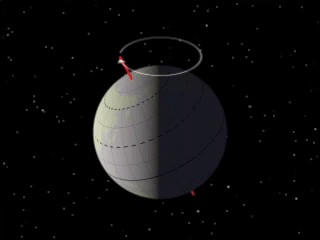Exploring Planetary Axes: The Search for Habitable Exoplanets
Written on
Chapter 1: The Role of Planetary Axes in Habitability
Understanding how the axial tilt of planets can influence their climates may provide crucial insights into which exoplanets could support alien life. Researchers from the Georgia Institute of Technology have recently devised computer simulations to explore how Earth's climate might adapt if our planet were situated in a binary star system. This research aims to identify which exoplanets could potentially develop and sustain life.
Binary star systems are more prevalent in our galaxy compared to solar systems like ours, which have only one star. Thus, the research team sought to investigate how planets within these complex systems behave under various gravitational forces.

Alpha Centauri, the nearest star system to Earth, features two main stars. Had Earth formed there, conditions would have been vastly different. The researchers noted, “Most Sun-like stars have at least one stellar companion, and the habitability of surrounding exoplanets is influenced significantly by this companion,” as detailed in their paper published in The Astrophysical Journal.
Section 1.1: Axial Tilt and Its Implications
A key factor affecting a planet's climate is its axial tilt, or obliquity. Earth's tilt changes gradually over time, while Mars exhibits a much more pronounced and rapid variation.
In the distant past, Mars possessed a significant atmosphere that supported extensive bodies of liquid water. However, the reasons for its transformation into a barren desert remain largely unknown. The drastic changes in Mars' axial tilt may have contributed to its climatic extremes, potentially extinguishing any life that once thrived there.

Over a 41,000-year cycle, Earth's axial tilt fluctuates between 22.1 and 24.5 degrees relative to the Sun, currently resting around 23.5 degrees. The Moon plays a crucial role in stabilizing this tilt; without it, Earth's axial position would be subject to greater variations due to gravitational interactions with neighboring planets.
Billy Quarles, a research scientist at Georgia Tech, noted, “Without the Moon, Earth's tilt could shift by as much as 60 degrees, potentially resembling Mars, where axial precession has likely led to atmospheric loss.”
Mars’ tilt can oscillate between 10 and 60 degrees over a two-million-year cycle. At the lower end, ice can accumulate near its poles, while at a 60-degree tilt, ice can form around the equator.
Section 1.2: Simulating Earth in Binary Systems
The research team began by simulating conditions on Earth if it orbited one of the stars in the Alpha Centauri system, the closest binary star system to our own. “We selected Alpha Centauri due to its main star's similarity to the Sun, the well-known orbits, and its public appeal,” Quarles explained.
Alpha Centauri A is a larger star, while its companion, Alpha Centauri B, is roughly similar to the Sun. The study focused on the dynamics of a hypothetical Earth orbiting around B and the gravitational effects of A.
The first video titled "Are We About to Discover Intelligent Alien Life? With Adam Frank" discusses the implications of this research in the search for extraterrestrial intelligence.
While a stable orbit could potentially develop around Alpha Centauri A, the same cannot be said for planets orbiting Alpha Centauri B. The highly elliptical orbit of A creates erratic gravitational effects on the system. Interestingly, introducing a Moon to this hypothetical Earth worsens the planet's stability, contrary to what we observe in our solar system.
Quarles elaborated, “Around Alpha Centauri B, a planet without a moon may have a more stable axial tilt compared to one that has a moon. The presence of a moon appears to exacerbate instability.”
Even in the absence of a moon, the axial fluctuations of planets near Alpha Centauri B may be too extreme for life to thrive.
The second video titled "We're Probably Wrong About What Alien Life Looks Like" explores the misconceptions surrounding the potential forms of extraterrestrial life.
The research team expanded their simulations to assess other binary systems, examining various combinations of star masses and orbital dynamics. The findings suggested that around 87 percent of the virtual Earth-like planets modeled would maintain an axial tilt comparable to that of Earth, raising hopes for the emergence of life on distant exoplanets.

The proximity of Alpha Centauri A and B is strikingly close—similar to the distance between our Sun and Uranus. In contrast, stars in other systems are often spaced farther apart, resulting in weaker gravitational interactions, which in turn allows for more stable axial tilts for their orbiting planets. This is promising for the ongoing search for extraterrestrial life.
Currently, astronomers have discovered over 4,000 planets orbiting distant stars, with many more awaiting confirmation. To date, no exoplanets have been confirmed in the Alpha Centauri A or B systems, although one planet is known to orbit Proxima Centauri, but it is unlikely to be habitable.
This research exemplifies pure scientific inquiry, as Quarles summarized, “We simply wondered what would occur if we were situated in a binary star system.”